Report to the
Governor in Council:
Status of Competition in Canadian
Telecommunications Markets
Deployment/Accessibility of
Advanced Telecommunications
Infrastructure and Services
September 2001
This publication is available electronically:
http://www.crtc.gc.ca
This publication can be made available in alternative format
upon request.
For additional copies of the report, please contact:
Public examination room
CRTC
1 Promenade du Portage
Hull, Québec
Mailing address:
CRTC
Ottawa, Ontario
K1A 0N2
Telephone: (819) 997-2429
1 (877) 249-2782
Ce document est également disponible en français.

Executive Summary
This is the first of five annual reports to the Governor in Council with respect to the status of competition in Canadian telecommunications markets and on the deployment and accessibility of advanced telecommunications infrastructure and services.
Telecommunications services play an increasingly important role in the Canadian economy. In 2000, industry gross revenues were approximately $28.7 billion and have been growing at an average rate of 9% per year since 1996.
In recent years, the telecommunications industry has undergone a profound transformation characterized by, among other things, increasing competition, the consolidation of companies, price wars, and the introduction, growth and bundling of products and services. Recently, the industry has been affected by the downturn in financial markets. Numerous companies have entered and exited the market and competitors, as a whole, continue to report net losses.
Some markets, such as business long distance, data, Internet, mobile, terminal equipment (e.g. telephones) and international, are significantly more competitive than other markets. For example, in 2000:
- competitors captured 49% of business long distance minutes (46% of revenues);
- international minutes were split approximately 50/50 between incumbent telephone companies and competitors;
- competitors accounted for 30% of data revenues; and
- Internet subscribers were served by non-incumbent carriers (41%), incumbent telephone companies (32%), large cable companies (19%) and others (8%).
Certain markets are not as competitive. For example, in 2000, the incumbents had over 80% of residential long distance minutes (73% of revenues). As well, in the local services market, the incumbents had 96% of total local lines in 2000. This market was opened to competition in 1997 and, to date, competition has primarily been in the urban business market.
Competitors continue to rely largely on the incumbents’ facilities and services in order to serve their customers. A key to facilities-based competition is the resolution of access issues related to municipal rights-of-way, support structures and multi-unit buildings. These issues are currently being addressed by the Commission and some matters are before the Courts.
Competition has led to greater choice of products, services and suppliers in both the business and residential markets. Customers, both business and residential, have seen significant price decreases for most services, including long distance, Internet, data, mobile and international. On the other hand, local residential rates have increased. However, depending on long distance usage, customers, whether business, residential, urban or rural, could have realized significant savings in combined long distance and basic local charges.
Canadian cable and telecommunications companies have made considerable investments in broadband infrastructure over the last several years. Approximately three-quarters of Canadians live in communities where high-speed services are provided by such companies. On a per capita basis, Canada is ahead of all other G8 countries in terms of subscription to high-speed services.
However, continued efforts and expenditures will need to be made. Approximately six million Canadians live in communities that do not have access to high-speed service. Absent programs or incentives to encourage investment in advanced telecommunications infrastructure, access to high-speed service may not be provided to all unserved communities by 2004.
Table of contents
1. Introduction *
1.1 Order in Council P.C. 2000-1053 *
1.2 CRTC Monitoring Plan *
1.3 Report scope and outline *
2. Overview of Telecommunications Industry and Regulation *
2.1 The CRTC and competition *
2.2 Volatility in the telecommunications services industry *
2.3 Telecommunications services in the economy *
3. Industry Players *
4. Status of competition *
4.1 Financial Indicators *
4.2 Wireline revenues *
4.3 Long distance services *
4.4 Local services *
4.5 Data and private line *
4.6 Internet access service *
4.7 Mobile services (cellular and PCS) *
4.8 International services *
4.9 Pay telephone services *
4.10 Satellite *
4.11 Terminal equipment *
4.12 Comparison to U.S. *
5. Impact of competition on customers *
5.1 Introduction *
5.2 Residential services *
5.3 Business services *
5.4 Internet services *
5.5 Mobile services (cellular and PCS) *
6. Broadband Infrastructure Deployment *
6.1 Introduction *
6.2 Deployment and Accessibility *
6.3 Investment in rural areas *
6.4 Promising means of accelerating private sector investment *
APPENDIX 1: GLOSSARY OF TERMS AND ACRONYMS
APPENDIX 2: PRESENCE OF LOCAL SERVICE PROVIDERS BY MAJOR URBAN CENTRE
APPENDIX 3: PRESENCE OF HIGH-SPEED INTERNET ACCESS SERVICE PROVIDERS BY MAJOR URBAN CENTRE
List of Figures
Figure 2.1 Evolution of gross revenues (1996 = 100) *
Figure 4.1 Total capital expenditures *
Figure 4.2 Earnings before interest, taxes, depreciation and amortization *
Figure 4.3 Earnings before interest, taxes, depreciation and amortization for competitors
*
Figure 4.4 Net income – incumbents and competitors *
Figure 4.5 Wireline business revenue share *
Figure 4.6 Wireline residential revenue share *
Figure 4.7 Average domestic long distance prices vs. minutes *
Figure 4.9 Business long distance share (revenues) *
Figure 4.10 Residential long distance share (minutes) *
Figure 4.11 Residential long distance share (revenues) *
Figure 4.12 Total long distance share for 2000 (minutes) *
Figure 4.13 Domestic long distance minute share (i.e. Canada-Canada) *
Figure 4.14 Competitor local lines by type of facility *
Figure 4.15 Virtual data network and IXPL revenues *
Figure 4.16 Data network and IXPL revenue by type of service *
Figure 4.17 Data network and IXPL market share *
Figure 4.18 Residential Internet penetration (percentage households) *
Figure 4.19 Internet market share (year 2000 subscribers) *
Figure 4.20 Internet subscribers by access technology (year 2000) *
Figure 4.21 Total high-speed Internet revenues *
Figure 4.22 Mobile service - Evolution of subscribers and spending *
Figure 4.23 Mobile subscribers as of June 2001 *
Figure 4.24 International minute share (non-U.S.) *
Figure 4.25 Incumbent market share in long distance (revenues) *
Figure 4.26 Competitor local market share (lines) *
Figure 5.1 Mobile monthly revenues per subscriber *
Figure 6.1 High-speed access by Canadian communities *
Figure 6.2 Access to high-speed service by province / territory * List of Tables
Table 2.1 Industry gross revenues – 1996 to 2000 *
Table 2.2 Segmented telecom industry revenues *
Table 4.1 Incumbent market share in long distance (minutes) *
Table 4.2 Total local lines (000s) *
Table 4.3 Total local business lines (000s) *
Table 4.4 Total local residential lines (000s) *
Table 4.5 Evolution of local market share *
Table 4.6 CLEC share of business lines in ILEC wire centres with co-location *
Table 4.7 High-speed Internet subscribers by Province / Territory in 2000 (000s)
*
Table 4.8 Percentage of FSAs with high-speed Internet service providers (2000)
*
Table 5.1 Annual residential savings (increases) *
Table 5.2 Residential local rates ($ per month) *
Table 5.3 Residential long distance monthly bill ($) *
Table 5.4 Annual business savings (increase) per line *
Table 5.5 Business local rates ($ per month) *
Table 5.6 Business long distance monthly bill per line ($) *
Table 6.1 Illustrative list of rural network initiatives *
Table 6.2 Illustrative list of funding alternatives for fibre projects * List of Maps
National mobile coverage (digital and analog service) *
Presence of mobile service providers *
High-speed Internet access in the North West Territories, Yukon and Nunavut *
High-speed Internet access in British Columbia *
High-speed Internet access in Alberta *
High-speed Internet access in Saskatchewan *
High-speed Internet access in Manitoba *
High-speed Internet access in Ontario *
High-speed Internet access in Quebec *
High-speed Internet access in Atlantic Canada *
1.1 Order in Council P.C. 2000-1053
This report is made in response to the Governor in Council direction to the CRTC issued on June 26, 2000, pursuant to Section 14 of the Telecommunications Act. This direction:
"(a) requires the Commission to submit, once in each year for the next five years, a report to the Governor in Council on the status of competition in Canadian telecommunications markets and on the deployment and accessibility of advanced telecommunications infrastructure and services in urban and rural areas in all regions of Canada,
(b) requires that the report include
(i) an examination of promising means for accelerating private sector investment in rural broadband infrastructure, such as initiatives to aggregate local demand for advanced telecommunications services, and
(ii) relevant data and analyses, and
(c) specifies that the first report be submitted to the Governor in Council no later than September 28, 2001."1 [Footnote: Order in Council P.C. 2000-1053, June 26, 2000.]
1.2 CRTC Monitoring Plan
Industry monitoring is a core activity of regulators, especially since the introduction of competition and further deregulation. Monitoring plays a role in making, validating and tracking the effects of regulatory decisions. As well, it provides the ability to assess competition and the deployment of advanced networks.
The CRTC Action Plan 2000-2003 sets out, as one of its activities, the monitoring of the Canadian telecommunications industry in order to determine more effectively a) the state of competition, b) the effect of competition on services to consumers, and c) the service providers’ compliance with legal and regulatory requirements. This report was prepared coincident with the implementation of the CRTC’s Monitoring Plan.
In order to determine the information needed for monitoring, the Commission initiated a process (Monitoring the Canadian Telecommunications Industry, Public Notice CRTC 2000-175, 15 December 2000), which included: (1) development of a background report,2 [Footnote:
"Monitoring the Canadian Telecommunications Industry - Background Report", Lemay-Yates Associates Inc., Initial Version – March 2001, Final Version - May 2001.] (2) consultation with industry, consumer groups and other interested parties,3 [Footnote: Public consultation was held in Hull, Quebec on April 18, 2001.] and (3) a survey of service providers to collect information to support analyses concerning the state of competition in telecom markets and the deployment of advanced infrastructure (CRTC Industry Survey – 2001).
The Commission would like to acknowledge and thank all those who took part in this process. In particular, the Commission would like to acknowledge those service providers who responded to the CRTC survey, which provided the information necessary to prepare much of this report.
1.3 Report scope and outline
This report is based on the responses to the CRTC Industry Survey – 2001, as well as other sources including Statistics Canada, Industry Canada, company financial reports, and information previously filed with the CRTC. Lemay-Yates Associates Inc. assisted in the development of this report.
The CRTC was able to obtain a significant amount of relevant information which has helped it to produce this report. However, certain information was not provided, was not available (denoted as n/a) or was not comparable. In addition, service coverage shown in the maps and tables may be somewhat over/understated due to the limitations of the survey. However, despite these limitations, the information presented in this report provides a meaningful depiction of the state of competition in the Canadian telecommunications markets.
In the development of future reports, the monitoring mechanisms and data collection will continue to be refined. For instance, the Commission intends to obtain more disaggregated information, such as a breakdown of data between small, medium and large business customers.
This Report is arranged as follows:
-
Section 2 provides a summary of major regulatory milestones in the development of competition, recent and ongoing developments in the industry, and an overview of the size of the telecommunications industry;
-
Section 3 presents a number of the major players in the Canadian telecommunications industry, where they operate and the services they provide;
-
Section 4 provides the status of competition in each of the major market segments, including long distance, local, data and private line, Internet, mobile, international, payphone, satellite and terminal equipment;
-
Section 5 examines the impact of competition on customers and in particular the pricing changes of telecommunications services, both business and residential; and
-
Section 6 reviews the status of broadband infrastructure deployment in Canada and considers the potential for the development of advanced infrastructure in rural and remote areas.
A glossary of terms and acronyms used in this report is found in Appendix 1.
2.1 The CRTC and competition
As the national telecommunications regulator, the CRTC has a vital role with respect to competition in Canadian telecommunications markets. Exercising its statutory powers both under predecessor legislation and the Telecommunications Act,4 [Footnote: Enacted in 1993, the Telecommunications Act for the first time authorized the Commission to deregulate services and provided more explicit powers to address other competition issues.] over the years the CRTC has, gradually and in an orderly manner, opened up monopoly-based markets to competition. In addition to setting the terms and conditions necessary to permit sustainable competition to evolve, the CRTC protects against anti-competitive behavior. When satisfied that particular markets are sufficiently competitive, the CRTC loosens its oversight through deregulation.
The CRTC’s underlying approach to opening up various market segments to competition is to weigh the potential advantages and disadvantages, and balance fairly the often conflicting interests of all concerned, including incumbents, competitors and customers. The following provides a brief summary of the most significant regulatory milestones in each of the various market segments.
The Data and Private Line service markets were the first telecommunications markets opened to competition. In 1979, the CRTC allowed the interconnection of private line data circuits between CNCP Telecommunications and Bell Canada. In 1997, the Commission deregulated high-speed interexchange private line services provided by the incumbent local exchange carriers (ILECs) connecting certain major urban centres. Since then, the Commission has further deregulated data and private line service markets.
In 1982, the CRTC allowed customers to purchase their own Terminal Equipment (telephones).
In 1984, the Commission set the terms and conditions for Wireless service providers to interconnect to the incumbent telephone companies’ networks.
In 1994, the CRTC deregulated both the Terminal Equipment and the Wireless markets, as they were sufficiently competitive.
Competition in the Long Distance market began on a resale basis in 1987, with the rules being liberalized in 1990. While facilities-based competition was permitted in 1992, true competition did not commence until 1994 when the incumbents were required to modify their networks to allow customers to make long distance calls without dialling extra digits (Equal ease of Access). In 1998, the CRTC considered that the long distance market was sufficiently competitive and ceased regulating the incumbents' retail rates.
The framework for facilities-based competition in the Local services market was established in 1997. In the following year the incumbents, as required by the CRTC, began to modify their networks to allow customers to switch service providers without changing telephone numbers (Local Number Portability).
In 1997, the Commission first deregulated the retail Internet services provided by the ILECs. In 1998, the CRTC deregulated these and other telecommunications services provided by the cable companies. However, the CRTC required that the ILECs and cable companies make available the underlying high-speed access capability to independent Internet service providers.
The CRTC first allowed the resale of International services in 1991 and permitted facilities-based competition in 1998. The Commission no longer regulates Teleglobe’s services.
In 1998, the Pay Telephone services market was opened to competition. New entrants were required to adhere to a series of consumer safeguards while incumbents were required to put in place access tariffs and service agreements.
In implementing its competitive frameworks, the Commission has adopted new processes, wherever possible, to expedite the resolution of competitive issues. For example, the CRTC Interconnection Steering Committee (CISC) process provides a forum for interested parties, with the assistance of CRTC staff, to resolve Local Competition implementation issues of a technological, operational or administrative nature. The CISC process has also been used for other matters, such as implementation of the new contribution regime, number administration and third-party Internet access to cable company facilities.
CRTC staff also assists in resolving carrier disputes, which avoids the need for formal Commission proceedings. In cases where a CRTC determination is ultimately required, this type of informal process enables the issues in dispute to be more narrowly defined and provides a means to obtain better information to be able to make a determination.
In addition to the above, the CRTC has issued several rulings (the most important ones are outlined below) in recent months that support the development of competition in the Canadian telecommunications industry. The data in this report does not generally reflect the impact of these recent decisions.
Effective 1 January 2001, the mechanism for the collection of contribution, which subsidizes the high cost of local service in rural and remote areas, was changed from a per-minute regime to one based on revenues. Previously, only long distance service providers paid contribution. The new mechanism is more competitively fair and equitable because now contribution is collected from all types of telecommunications service providers.
Unbundled loop rates paid by competitive local exchange carriers (CLECs) to provide local services were reduced on average by up to 39% in early 2001.
The Direct Connection (DC) rates were reduced for all major ILECs (except SaskTel) from $0.007 to $0.003 per minute in March 2000. SaskTel's DC rate was reduced to $0.005 per minute in December 2000. This lowered the cost that long distance service providers pay the Local Exchange Carriers (ILECs and CLECs) to originate and terminate their long distance calls to and from the local network.
Co-location rules were, and continue to be, liberalized in 2001. The first of these changes had been to allow competitors to have unsegregated space in ILECs’ Central Offices as well as not requiring them to be escorted to their facilities.
Local competitors will continue to be able to obtain critical inputs such as unbundled loops at regulated cost-based rates until the Commission determines that there is sufficient facilities-based local competition.
Co-location and ILEC unbundled loops were made available in October 2000 to resellers that offer broadband and other data access services.
The Commission determined the terms and conditions for access by Ledcor Industries and its affiliates to municipal rights-of-way in Vancouver. The matter is currently before the Federal Court of Appeal.
2.2 Volatility in the telecommunications services industry
In recent years, the telecommunications industry in Canada has undergone a profound transformation. This transformation has been characterised by:
-
opening markets to competition and increasing industry deregulation;
-
the entry and exit of numerous companies in the long distance and local services markets;
-
the break-up of the national alliance of incumbent carriers (Stentor);
-
the entry of incumbent carriers, as competitors, into the operating territories of other incumbents;
-
the consolidation of industry players;
-
price wars in long distance, mobile and internet markets;
-
advances in technologies; and
-
introduction, growth and bundling of products and services.
Similar trends are affecting the telecommunications industry worldwide. More recently, the telecommunications industry has been affected by the downturn in financial markets.
2.3 Telecommunications services in the economy
Telecommunications services play an increasingly important role in the Canadian economy. In 1995, telecommunications services revenues represented 2% of gross domestic product. This grew to approximately 3% by 2000 - a 50% increase.5 [Footnote: "Telecommunications Services in Canada, An Industry Overview, 1999-2000, Industry Canada, 2001. Figure for 2000 was estimated using information from Statistics Canada.]
In 1999, companies in the telecommunications services industry invested over $7.6 billion6 [Footnote: All dollar figures in this report are Canadian nominal dollars (i.e. non-adjusted for inflation), unless indicated otherwise.] in capital equipment and assets, and employed over 95,000 people.7 [Footnote: Source: Financial reports of companies. Incumbents include Bell Canada, TELUS, Aliant, MTS, SaskTel, and Teleglobe. Competitors include AT&T Canada, Call-Net, GT Group, Rogers AT&T, Clearnet and Microcell.]
Industry gross revenues have been growing at a rate of 9% per year from $20.5 billion in 1996 to $28.7 billion in 2000.
Wireline local, long distance, data and Internet service revenues, representing over 75% of industry revenues in 2000, have been growing, on average, at 7% per year while mobile services (excluding satellite) have grown at 20% per year.8 [Footnote: Estimated by Lemay-Yates Associates Inc. Wireline figures are based on reported results of carriers and include inter-carrier payments, i.e. payments made from one telecom service provider to another. Wireline figures also include Internet and data revenues of telecommunications carriers and major cable companies. Mobile figures for 1996 to 1999 are from Statistics Canada. Figures for 2000 were estimated using company reports.]
Table 2.1
Industry gross revenues – 1996 to 20009
[Footnote: Percentages are stated as Cumulative Annual Growth Rate (CAGR).]

The more rapid growth in mobile revenues as compared to wireline revenues is illustrated graphically in the figure below.
Figure 2.1
Evolution of gross revenues (1996 = 100)

The following table illustrates that the data and Internet markets are the fastest growing market segments.10 [Footnote: Estimated by Lemay-Yates Associates Inc. Figures based on company financial reports. Reported revenues include inter-carrier payments. Internet includes only the following companies: Bell Canada, TELUS, Aliant, MTS, AT&T Canada, Rogers, Shaw, Vidéotron and Cogeco.]
Table 2.2
Segmented telecom industry revenues

The significant growth rates of the data, mobile and Internet markets reflect, in part, technological change and the increasing use of the relatively new services in these markets. These annual growth rates may not be sustained in the long term as the markets mature.
BCE Inc. – is the largest telecommunications holding company in Canada. BCE owns, directly or indirectly, in whole or in part, Bell Canada, Aliant Telecom Inc., Northwestel Inc., Télébec ltée, Northern Telephone Limited, Telesat Canada, Teleglobe Inc., Bell Mobility Cellular Inc. and BCE Nexxia Inc. Bell is the incumbent carrier in most of Ontario and Quebec, Télébec and Northern are the incumbents in parts of those provinces, and Northwestel is the incumbent in Yukon, Northwest Territories and Nunavut. In addition, BCE also has significant broadcasting and print interests (such as CTV, specialty channels, Bell ExpressVu and the Globe and Mail).
Bell Canada – provides long distance and local services as the incumbent carrier throughout most of Ontario and Quebec. These and other services are also provided by affiliates in its own territory and elsewhere (as a new entrant) in Canada. Bell’s affiliates provide mobile, data, satellite and international services in most of Canada. As well, a Bell affiliate is the largest Internet service provider in Canada (marketed as Sympatico). SBC Communications Inc., a U.S. company, holds a minority interest in Bell Canada. In 2000, Bell Canada had assets of $22.8 billion and revenues of $13.2 billion.
Aliant – is the incumbent carrier in the provinces of Nova Scotia, New Brunswick, Prince Edward Island and Newfoundland. These provinces were served by Maritime Tel & Tel Ltd., NBTel Inc., Island Telecom Inc. and NewTel Communications Inc. respectively which amalgamated to form Aliant Telecom Inc. in early 2001. BCE owns 53.3% of Aliant. Aliant and its affiliated companies provide long distance and local, data, wireless and Internet services throughout its incumbent territory. In 2000, Aliant had assets of $3.7 billion and revenues of $2.2 billion.
MTS Communications Inc. – is the incumbent carrier in the province of Manitoba. MTS has majority ownership in Bell Intrigna Inc. and BCE owns a minority interest in both MTS and Bell Intrigna Inc. MTS provides long distance, local and data services as the incumbent carrier in the province of Manitoba. Bell Intrigna provides these and other services, such as data and Internet, as a new entrant in Alberta and British Columbia. MTS affiliates provide wireless, data and Internet access in its incumbent territory. In 2000, MTS had assets of $1.4 billion and revenues of $822 million.
TELUS Corporation (TELUS) – is the second largest telecommunications holding company in Canada. TELUS owns, directly or indirectly, in whole or in part, TELUS Communications Inc. (TCI), Tele-Mobile Company Inc., Clearnet Communications Inc. and TELUS Communications (Québec) Inc. TCI is the incumbent carrier in Alberta and British Columbia. These provinces were served by TCI and TELUS Communications (B.C.) Inc. (formerly BC TEL). TELUS Québec, formerly Québec-Telephone, is the incumbent carrier in part of Quebec. TCI provides long distance and local services as the incumbent carrier in the provinces of Alberta and British Columbia, while TELUS Québec provides these services in a portion of Quebec. Affiliates provide these and other services in TCI’s territory and elsewhere (as a new entrant) in Canada. TELUS provides wireless and Internet services in most of Canada via its subsidiaries. Verizon Communications Inc., a U.S. company, holds a minority interest in TELUS. In 2000, TCI had assets of $16.4 billion and revenues of $3.9 billion.
Saskatchewan Telecommunications (SaskTel) – is the incumbent carrier in the province of Saskatchewan. SaskTel is a subsidiary of Saskatchewan Telecommunications Holding Corporation, a Government of Saskatchewan crown corporation. SaskTel provides long distance, local and data services as the incumbent carrier in the province of Saskatchewan. SaskTel will provide competitive long distance and data services in British Columbia upon completion of its acquisition of RSL COM Canada. SaskTel affiliates provide wireless and Internet services in its territory. In 2000, SaskTel had assets of $1.1 billion and revenues of $626.6 million.
Other incumbent telephone companies – there are a number of smaller incumbent telephone companies in Ontario and Quebec, and one in British Columbia. They provide local, data, Internet and other services. A few also provide long distance service. Some are municipally owned.
AT&T Canada Inc. – owns AT&T Canada Telecom Services Company (AT&T Canada), the largest competitive carrier in Canada. It includes the former operations of various companies, including ACC TelEnterprises Ltd., Netcom Canada Inc., MetroNet Communications Group Inc., and AT&T Canada Long Distance Services Company. AT&T Canada provides business customers with long distance, data, Internet access and other telecommunications services throughout most of Canada as well as local services in major centres across Canada. AT&T Corp., a U.S. company, owns a minority interest in AT&T Canada. In 2000, AT&T Canada had assets of $4.3 billion and revenues of $1.5 billion.
Call-Net Enterprises Inc. (Call-Net) – is the second largest competitive carrier in Canada. It includes the former operations of fONOROLA Inc. Sprint Corp., a U.S. company, owns a minority interest in Call-Net. Call-Net provides business and residential customers with long distance, data, Internet access and other services throughout most of Canada as well as local services in major centres across Canada. In 2000, Call-Net had $2.9 billion in assets and $1.2 billion in revenues.
GT Group Telecom Inc. (GT Group) – began as a CLEC in 1998. GT Group primarily provides business customers data, long distance and local services in major centers across Canada. As of September 2000, it had year-end assets of $1 billion and revenues of $73.2 million.
Futureway Communications Inc. (Futureway) – is a subsidiary of Concillium Utility Investment Corp. A Rogers Communications Inc. subsidiary has a minority interest. Futureway provides business and residential customers in Toronto and the surrounding area with local, long distance, data and Internet services.
Microcell Telecom Inc. (Microcell) – provides mobile services throughout most of Canada. Microcell recently received approval to operate as a CLEC in TCI's operating territory. Microcell had $1.2 billion in assets and $428.8 million in revenues in 2000.
Rogers Communications Inc. (Rogers) – owns the largest cable operations in Canada and is a major provider of high-speed Internet service, primarily to residential customers. Its affiliate, Rogers AT&T Wireless, is one of the largest mobile voice service providers. Rogers also has significant broadcasting and print interests, including specialty channels and magazines (such as CFMT and MacLean's). In 2000, Rogers had $7.8 billion in assets and $3.1 billion in revenues.
Other incumbent cable operators – include Shaw Communications Inc. (Shaw), Le Groupe Vidéotron ltée (Vidéotron), Cogeco Inc. and Eastlink Limited (Eastlink). These companies and Rogers are the largest providers of high-speed Internet access in Canada. Some of these companies also offer data services to business customers. Eastlink also provides residential customers local and long distance services in Halifax and Charlottetown where it is the incumbent cable operator. Shaw owns specialty channels and StarChoice. Vidéotron’s parent has significant broadcasting and print interests.
Resellers – began as long distance resellers in the late 1980s and early 1990s. They lease facilities and resell services of carriers. As they are not facilities-based carriers, they are not subject to Canadian ownership and control requirements. These companies provide business customers with resold long distance, local and other services and residential customers with resold long distance. Some of the largest resellers include Primus Telecommunications Canada Inc. and Distributel Communications Limited.
Independent Internet service providers (ISPs) – There are hundreds of ISPs. Like resellers, they are not facilities-based carriers. These companies provide business and residential customers with data and Internet services. The largest ISPs include AOL Canada and Worldcom Canada.
4.1 Financial Indicators
In 2000, total capital expenditures, including both the wireline and mobile segments, were $7.5 billion, a 10% annual growth rate since 1996. The incumbents increased capital expenditures from $3.8 billion to $5.9 billion, representing an annual growth rate of 12% since 1996. Competitors increased capital expenditures from $1.4 billion in 1996 to $2.3 billion in 1999. In 2000, competitors reduced capital expenditures to $1.6 billion, due, in part, to the downturn in the financial markets which reduced their ability to access capital.
Figure 4.1
Total capital expenditures11
[Footnote: Source: Financial reports of companies. Incumbents include Bell Canada, TELUS, Aliant, MTS, SaskTel, and Teleglobe. Competitors include AT&T Canada, Call-Net, GT Group, Rogers AT&T, Clearnet and Microcell.]

Total Earnings before Interest, Taxes, Depreciation and Amortization (EBITDA) has experienced 5% annual growth since 1996. The incumbents’ EBITDA growth has been approximately 7%.
Figure 4.2
Earnings before interest, taxes, depreciation and amortization12
[Footnote: Ibid.]

The competitors, however, have not been able to match this performance. Over the 1996 to 2000 timeframe, the competitors’ EBITDA has generally been slightly positive except for 1998.
Figure 4.3
Earnings before interest, taxes, depreciation and amortization for competitors13
[Footnote: Ibid.]

In 1998, both the wireline and mobile competitors experienced negative EBITDA of $35 million and $116 million respectively. Although the competitors overall had a positive EBITDA of $250 million in 2000, the wireline competitors had a negative EBITDA of $39 million. Due, in part, to the negative cash flow generally experienced by wireline competitors, several local service providers went into receivership and subsequently ceased operations.
Total net income increased from $0.2 billion in 1999 to $0.7 billion in 2000. Net income for the incumbents has grown from $1.8 billion to $2 billion in the same period, a 13% increase. The competitors, however, experienced negative net income in both 1999 and 2000. Over those years, the mobile competitors have reduced their net loss from $1.1 billion to $0.3 billion, whereas the wireline competitors saw their net loss increase from $0.5 billion to $1.0 billion.
Figure 4.4
Net income – incumbents and competitors14
[Footnote: Ibid.]

In recent years, as illustrated in Table 2.2, long distance revenues have decreased on average by 8% per annum. Unlike the incumbents, the wireline competitors have not been able to offset these decreases from revenues in other markets, particularly given their recent entry into local markets.
4.2 Wireline revenues
Local and long distance service revenues (including data) make up over 75% of industry gross revenues and continue to be generated largely by the incumbent telephone companies. Over 50% of industry wireline revenues are accounted for by one entity, Bell Canada.15 [Footnote: In 2000, Bell Canada accounted for over $11.7 billion out of $23.3 billion in wireline revenues.]
Competitors have taken a greater market share of the business market than the residential market. In the business market, their share of total wireline service revenue increased four years in a row, from 17% in 1997 to 26% in 2000. By contrast, between 1997 and 2000, their share of the residential market has remained relatively unchanged (13% in 2000).
Figure 4.5
Wireline business revenue share

Figure 4.6
Wireline residential revenue share
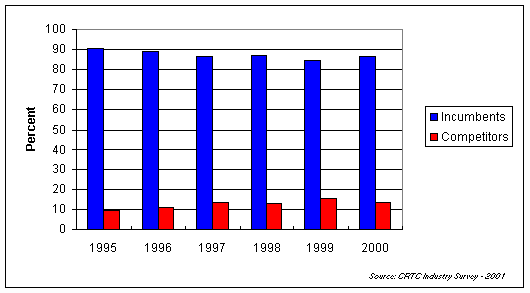
4.3 Long distance services
Long distance resale began in the late 1980s. Facilities-based competition began in 1992.
In 1998, the Commission ceased regulating the incumbents’ long distance rates. In that year, significant price decreases, such as flat-rate calling plans, were implemented. These decreases resulted in a significant increase in long distance minutes and reduced margins. The long distance market has essentially become a commodity market.
Domestic (i.e. Canada-Canada) long distance makes up over 70% of the total long distance market minutes. Since competition was introduced, long distance domestic minute growth has continually increased as prices have declined as demonstrated below.16 [Footnote: CRTC Industry Survey – 2001, previous filings and internal estimates.]
Figure 4.7
Average domestic long distance prices vs. minutes

In business markets, competitors captured 49% of the long distance minutes in 2000, up from 45% in 1998, but down from 1999. During the same period, the competitors’ share of long distance business revenues declined from 51% to 46%.
Figure 4.8
Business long distance share (minutes)

Figure 4.9
Business long distance share (revenues)

In residential markets, the competitors' share of minutes in 2000 is much lower, having declined to about 18% from 26% in 1998. During the same period, the competitors’ share of residential long distance revenues declined from 31% to 27%.
Figure 4.10
Residential long distance share (minutes)

Figure 4.11
Residential long distance share (revenues)

In 2000, the competitors captured 34% of total long distance minutes. Approximately 45% of their minutes were carried on their own facilities, the remainder through resale (i.e., leasing the facilities or reselling the services of another carrier). With the decline in long distance prices, the margins available to resellers have shrunk.
Figure 4.12
Total long distance share for 2000 (minutes)

ILECs continue to retain a majority of the domestic long distance market and in recent years, competitors’ domestic long distance market share (minutes) has been approximately 40% as displayed in the following figure.
Figure 4.13
Domestic long distance minute share (i.e. Canada-Canada)

By year-end 2000, at least one long distance competitor was serving customers in 99% of Canada’s FSAs.17 [Footnote: Source: CRTC Industry Survey – 2001. FSA stands for Forward Sortation Area i.e., the first three digits of the six digit postal code.] Competitive presence is found in all provinces. Long distance competition was recently permitted in the Yukon, Northwest Territories and Nunavut, and will be permitted, effective 1 January 2002, in the territory served by O.N.Telcom.
The development of long distance competition has not been uniform across Canada. While Bell Canada’s market share (minutes) has declined to 61%, TCI's market share is 71%, and other incumbents’ market shares are 80% or more.18 [Footnote: Based on the ILECs’ Annual Reports and internal estimates.]
Table 4.1
Incumbent market share in long distance (minutes)

4.4 Local services
The framework for local competition was established in mid-1997. However, it was not until 1998 that facilities-based competition began.
Local competition in the serving territories of Télébec and TELUS Québec will be permitted in 2002. In the Yukon, Northwest Territories and Nunavut and in the serving territories of the smaller ILECs (mostly in Ontario and Québec), local competition has yet to be introduced.
CLECs have several options to access their customers: resale of retail services, the lease of ILEC unbundled loops19 [Footnote: In Decision 97-8, the CRTC mandated the unbundling of certain ILEC service and facilities that CLECs would require and would not generally be able to provide themselves. "Loop" is the term used to describe the "last mile" connection from the telephone company Central Office (switching centre) to the customer’s premises.] and building their own facilities. CLECs typically use a combination of these options to access their customers. With Microcell recently obtaining CLEC status in TCI's operating territory, a fourth option involves the provision of local services using wireless infrastructure.
To date, access by CLECs and resellers has been primarily achieved through reselling Centrex services of the ILECs. Leasing ILEC unbundled local loops by CLECs accounted for about 18% of competitor lines in 2000. A third option is for CLECs to provide their own facilities, including the local loop, all the way to the customer premises. This accounted for only about 33% of competitor lines in 2000.
Figure 4.14
Competitor local lines by type of facility

Total voice lines in Canada, residential and business, are shown in the following tables, along with competitor share.20 [Footnote: CRTC Industry Survey – 2001 and internal estimates for Tables 4.2 to 4.5. ILEC lines include those resold by CLECs and resellers (e.g. Centrex resale).]
Table 4.2
Total local lines (000s)

Table 4.3
Total local business lines (000s)

Table 4.4
Total local residential lines (000s)

By the end of 2000, competitors had captured 4% of total voice lines. Their share of the business line market, approximately 10%, was significantly higher than the 0.2% they achieved in the residential market. Cable companies have generally not entered the residential market as originally anticipated in 1997 when the framework for local competition was established. In addition, several CLECs, such as Norigen Communications Inc., Axxent Corp., C1.com Inc. and Cannect Communications Inc., have recently gone into receivership and ceased operations. Generally, their customers have been transferred to other CLECs.
The overall evolution of competitor market share is shown below.21 [Footnote: CRTC Industry Survey – 2001 and estimates for non-reporting competitors, including resale.]
Table 4.5
Evolution of local market share

A key to the continued development of local competition has been the ability of CLECs to use ILEC loops at cost-based rates and by co-locating22 [Footnote: Co-location refers to an arrangement whereby competitors of an ILEC locate their equipment in or near the ILEC's central office.] in ILEC wire centres under reasonable terms and conditions. CLECs have been able to co-locate in ILEC wire centres since mid-1997.
CLEC business-line share has been greater in wire centres where co-location has been established. Table 4.6 shows CLEC business line share in ILEC wire centres in a number of Canada’s largest markets where CLECs have co-located.
Table 4.6
CLEC share of business lines in ILEC wire centres with co-location23
[Footnote: CRTC Industry Survey – 2001.]

In addition to these markets, CLECs also reported lines in 2000 in centres such as Québec City, Hamilton, Kitchener/Waterloo, London and Victoria. One or more competitors, including resellers, also provide service in smaller urban centres such as Regina, Sudbury and Trois-Rivières via resale of ILEC Centrex service.
Another key to the development of local competition is the ability for customers to change service provider without changing their telephone number (LNP). As of March 2000, approximately 37% of working telephone numbers were in LNP-enabled exchanges.24 [Footnote: Source: CRTC Telephone Number Utilization Report.]
Resolution of access issues related to rights-of-way, support structures and multi-unit buildings is key to facilities-based competition. These issues are currently being addressed by the Commission and some matters are before the Courts.
As noted above, competitors are primarily serving business rather than residential customers. As well, the presence of competitors is largely in urban centres.
The presence of local service providers in most of the major cities across Canada is illustrated in Appendix 2.
4.5 Data and private line
Modern switching and computer technology has made possible a proliferation of data services. These services are available from a wide variety of suppliers including the ILECs, CLECs and others. They are provided at speeds from 56/64 kilobits per second to several gigabits per second.
Competition was first permitted in interconnected interexchange private line (IXPL) data services in 1979. Since then, competition has evolved to such a degree that the Commission has deregulated all data services provided by competitors and most of those provided by the ILECs.
In the case of high-speed IXPL services provided by the ILECs, the Commission has deregulated all routes between major cities as well as many between smaller centres (in total over 1,100 routes). These services are used by customers and competitors to provide both data and voice services.
Data services have been a source of significant growth for the industry. Total revenues were approximately $4.6 billion in 2000, having grown at 28% since the previous year.
Data services have been shifting from "private line" dedicated connections to data network services that make use of frame relay, ATM, IP and other protocols, which manage data flow using shared facilities.
The shift in data from private line to virtual data networking is shown below.
Figure 4.15
Virtual data network and IXPL revenues

Data service has also been evolving towards higher speed services. In terms of revenue, narrowband services have declined from almost 50% of the market in 1995 to approximately 20% in 2000. Over the same period, wideband and broadband services’ share of the market has increased.
Figure 4.16
Data network and IXPL revenue by type of service25
[Footnote: In the CRTC Industry Survey - 2001, bandwidth is defined as follows: "Narrowband" - two-way capabilities with speeds in either direction not exceeding 64 Kbps; "Wideband" - two-way capabilities with speed in either direction of greater than 64 Kbps up to and including 1.544 Mbps; and "Broadband" - two-way capabilities with speed at least one direction exceeding 1.544 Mbps.]

Competitors accounted for some 30% of data revenues in 2000, up from 19% in 1997.
Figure 4.17
Data network and IXPL market share

4.6 Internet access service
Due to the significant degree of competition, the Commission does not regulate retail Internet services. The Commission does, however, regulate the rates, terms and conditions for access to services and facilities upon which ISPs depend.
In 1999, the Commission established a basic service objective which includes the capability for dial-up connection to the Internet without incurring long distance charges. At that time, over 97% of ILEC lines met this objective.26 [Footnote: Telephone Service to High-Cost Serving Areas, Telecom Decision CRTC 99-16, 19 October 1999.]
In 2000, 40% of households had Internet access, translating into over 12 million users.27 [Footnote: Per Statistics Canada – Population per Cansim Matrices 6367-6378 and 6408-6409; Internet penetration per Household Internet Use Survey 2000, 56M0002XCB, July 2001, Table 2.]
Figure 4.18
Residential Internet penetration (percentage households)

In 2000, 51% of Canadian households had at least one member who was a regular Internet user, up from 42% in 1999.28 [Footnote: Ibid.]
The following figure provides a breakdown of the Internet access market (dial-up and high-speed) at the end of 2000, by category of service provider.
Figure 4.19
Internet market share (year 2000 subscribers)

The following figure shows the breakdown of Internet subscribers by type of access technology. Approximately 60% of all Internet subscribers in 2000 used low-speed dial-up access (i.e., access to Internet via a regular telephone line).
Figure 4.20
Internet subscribers by access technology (year 2000)

Competitors, including independent ISPs, provide dial-up and high speed Internet access services, mainly through the use of ILEC facilities and services. Technology, which will allow ISPs to provide high-speed service through the use of cable company access facilities, is being developed.
Even though 60% of customers access the Internet via regular dial-up lines, high-speed Internet revenues are the fastest growing portion of the Internet market.
Figure 4.21
Total high-speed Internet revenues

The following table provides an overview of the distribution of high-speed Internet customers by province / territory.29 [Footnote: CRTC Industry Survey - 2001 and CRTC internal data.]
Table 4.7
High-speed Internet subscribers by Province / Territory in 2000 (000s)
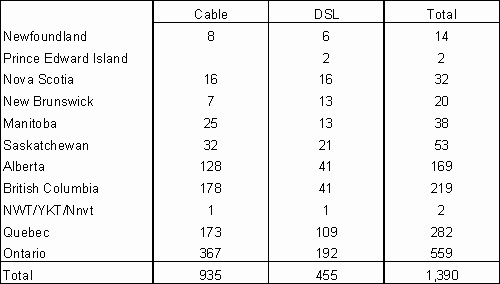
By year-end 2000, at least one dial-up Internet service provider was serving customers in virtually all FSAs. Almost 100% of Canadian households are within these areas.
The following table shows the presence of high-speed Internet access providers by province / territory at the end of the first quarter 2001.30 [Footnote: Source: CRTC Industry Survey - 2001. Due to limitations in service coverage, high-speed Internet service is not available to all residences and businesses throughout the FSAs in which one or more service providers are present.]
Table 4.8
Percentage of FSAs with high-speed Internet service providers (2000)
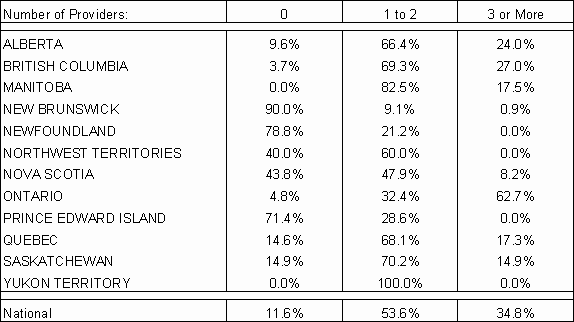
Maps showing the presence of high-speed Internet access providers for certain major urban centres are provided in Appendix 3.
4.7 Mobile services (cellular and PCS)
In 1984, the ILECs and Rogers Cantel Inc., now Rogers AT&T Wireless, were licensed by Industry Canada to provide analog cellular services. In 1995, Mobility Canada (a consortium of the ILECs’ mobile operations), Rogers AT&T Wireless, Microcell and Clearnet were licensed to provide digital Personal Communications Services (PCS). Mobility Canada has since been dissolved. TELUS Mobility (with its acquisition of Clearnet) and the Bell wireless alliance (having acquired new spectrum) now compete nationally with Rogers AT&T Wireless and Microcell.
Since the mobile services market (cellular, PCS, paging and other) is sufficiently competitive, the Commission does not regulate mobile service rates.
Mobile telephony reaches over 94% of the Canadian population, and the industry expects to achieve 50% penetration of the Canadian population by 2004.31 [Footnote: Submission to the Standing Committee on Finance in preparation for The Year 2002 Budget, Canadian Wireless Telecommunications Association (CWTA), August 10, 2001]
As shown in the following figure, the number of subscribers to mobile wireless services has increased significantly, while average monthly spending has declined.32 [Footnote: Subscriber figures from the "Mobile Wireless Subscribers in Canada", Canadian Wireless Telecommunications Association (CWTA). Evolution of average monthly revenues per user (ARPU) from Company Annual Reports, weighted average by CWTA-reported subscriber figures.]
Figure 4.22
Mobile service - Evolution of subscribers and spending

The following table shows the number of mobile subscribers for the four main carriers.
Figure 4.23
Mobile subscribers as of June 200133
[Footnote: "Mobile Wireless Subscribers in Canada", CWTA.]
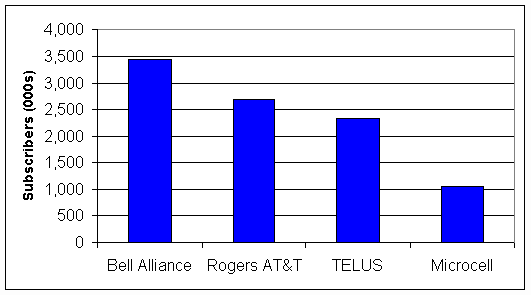
The following maps show the mobile coverage across the country first, by the type of technology (digital vs. analog) and then by the number of service providers.34 [Footnote: Source: Information obtained from company websites.]
National mobile coverage (digital and analog service)

Presence of mobile service providers

4.8 International services
Prior to 1998, international services (calling non-U.S. international destinations) were primarily provided on a monopoly basis by Teleglobe. The international services market was opened to facilities-based competition in 1998 (2000 in the territories served by Northwestel). Since that time, the Commission has refrained from regulating these rates and competitors have captured approximately half of the market.35 [Footnote: Source: CRTC Industry Survey - 2001.]
The following figure shows that the retail market for international calls is just as competitive as the international services market.
Figure 4.24
International minute share (non-U.S.)36
[Footnote: Source: CRTC Industry Survey - 2001 and internal estimates.]
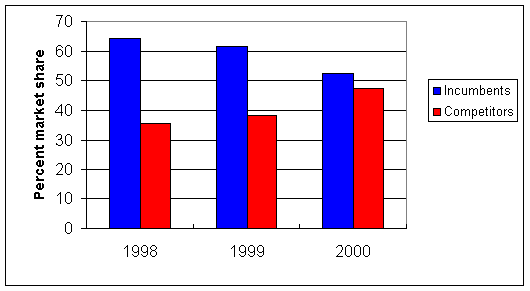
The most popular non-U.S. destinations are the U.K., France and India. Average per minute rates for these and many other destinations have declined considerably since 1998 due to the combined effect of greater competition and lower international settlement rates.
4.9 Pay telephone services
In June 1998, the Commission allowed competition in the provision of pay telephone service and established consumer and social safeguards. As part of this competitive framework, the Commission requires the ILECs to file periodic reports on payphone removals.
The Commission has refrained from regulating the rates of new entrants but has retained rate regulation of pay telephone services offered by the ILECs. In addition, the ILECs have, as directed by the CRTC, provided the underlying loop service supporting competitors’ pay telephone service and entered into billing and collection agreements with the new entrants.
By January 2001, 300 potential service providers had registered with the Commission. However, only about 3,500 competitive pay phones had been placed in service. Two companies have developed a national presence (representing approximately 60% of competitive payphones) with others offering service in specific geographic locations.
The ILECs offer pay telephone service within their own operating territories with about 170,000 coin or card telephones installed across Canada.
4.10 Satellite
Satellites are used to carry a wide range of communications services such as voice and data, broadcasting communications, direct-to-home broadcast services (DTH) and mobile communications.
Traditionally, domestic fixed and broadcast satellite services were provided in Canada on a monopoly basis by Telesat. In March 2000, Telesat’s monopoly ended and the Commission no longer regulates its rates.
Including Telesat’s satellites, there are now 50 satellites approved for fixed satellite service (FSS) in Canada,37 [Footnote: Industry Canada, List of approved FSS satellites, September 1, 2001.] thereby giving Canadian customers more choice. At the same time, Telesat and other Canadian providers may also now compete in the broader North American marketplace.
4.11 Terminal equipment
As early as 1982, the CRTC allowed the attachment of subscriber provided terminal equipment (such as telephones) to the lines and networks of the ILECs. The Commission no longer regulates the provision of terminal equipment because there is sufficient competition in this market, as demonstrated by the multitude of service providers and consumer retail outlets offering a wide variety of products and services.
4.12 Comparison to U.S.
The following figure compares the development of competition in the long distance services markets in Canada and the U.S.38 [Footnote: Canadian figures are from CRTC Industry Survey – 2001. U.S. figures are from FCC Statistics of Common Carriers, August 2000, Tables 1.5 and 1.6. U.S. figures represent AT&T Corp. share of long distance amongst long distance carriers (i.e. excluding intra-LATA toll service provided by the local telcos).] Incumbent share of the long-distance market in both countries declined to about 70% some five years after competition was introduced.39 [Footnote: Competition in the public-switched long distance services market began in the U.S. in 1984 and in Canada in 1992.]
Figure 4.25
Incumbent market share in long distance (revenues)

A comparison of Canada and the U.S. in terms of the development of competition in local services is provided in the following figure.40 [Footnote: Canadian figures are from CRTC Industry Survey - 2001. U.S. figures are from FCC Common Carrier Bureau, Industry Analysis Division, "Local Telephone Competition – Status as of December 31, 2000" and "Local Competition, December 1998". U.S. figures for 1997 and 1998 are based on unbundled loops and resale only.] Competitor penetration of Canadian local line markets has been relatively consistent with the experience in the U.S., given the different dates when the markets were opened to competition.41 [Footnote: Competition in local markets in the U.S. effectively began in 1996 with the passage of the Telecommunications Act of 1996. Local markets were opened to competition in Canada in mid-1997, resulting in competitive entry later that year.]
Figure 4.26
Competitor local market share (lines)
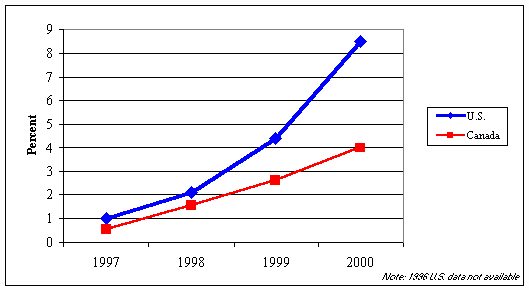
5.1 Introduction
With the introduction of competition, customers have benefited in a number of ways. Competition has provided an increased choice of service providers and new services, as well as benefits such as loyalty programs. Marketing plans have allowed customers to increase their long distance calling without increased spending. Also, competition has brought significant reductions in prices in many of the markets, the most notable being long distance, Internet, data and private line, mobile and international.
In order to provide an indication of the impact of competition on customers, this section reviews price changes that have taken place in certain of the market segments in Canada.
5.2 Residential services
Long distance rates have plummeted since the early 1990s. In addition, differences in pricing (e.g. peak versus off-peak rates) have largely vanished. Long distance is now a low priced service, with average rates in 2000 some one-third of what they were in 1995.
In order to bring rates closer to costs, basic local residential rates have increased. Rural42 [Footnote: Rural areas are defined as those centres having a population of less than 10,000 while urban areas are defined as those areas having a population greater than 100,000.] rates have tended to increase more than urban rates because they were generally lower than urban rates despite the higher cost of providing rural phone service. In addition, rates for certain optional local services have increased since the introduction of price cap regulation. There has also been a significant amount of service bundling for customers.43 [Footnote: Typically, service bundles offer several services for one price which is less than the sum of the individual prices for each bundled element.]
The table below shows the impact of the change in residential telephone rates, by province between 1995 and 2000.44 [Footnote: For illustration purposes, a consumer with one residential line and 125 billed minutes of domestic long distance (Canada-Canada) per month using blended peak/off-peak pricing information was used. This is approximately equal to the national residential average. Actual consumer bills would have varied according to location and specific usage patterns. All figures exclude sales taxes.] As illustrated, assuming 125 long distance minutes per month, higher local rates were more than offset by savings from lower long distance rates. On that assumption, rural residential consumers would have realized savings in 2000 between $143 and $297. In all provinces, except New Brunswick, urban consumers, on average, would have saved more than rural consumers.
Table 5.1
Annual residential savings (increases)45
[Footnote: Calculations in Tables 5.1 to 5.6 are based on information obtained from the CRTC Industry Survey – 2001.]
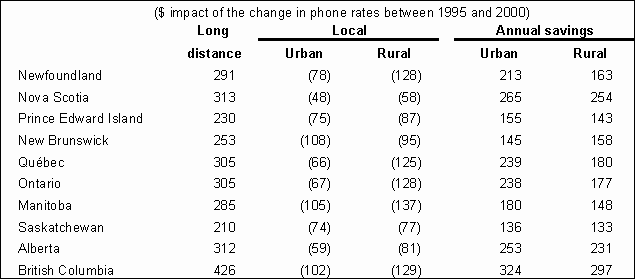
Individual customer savings would have varied, depending upon location, calling volume and calling patterns. For example, consumers who did not make any long distance calls would have paid between $48 to $137 more in 2000 than in 1995 for telephone service.
In addition, a residential consumer would have saved approximately 40% since 1995 on U.S. long distance rates. Additional savings would have been made on overseas calls. For example, rates to the top three non-U.S. international destinations, the U.K., France and India, have fallen, on average, by over 50% since 1995.46 [Footnote: CRTC Industry Survey – 2001 and data from previous proceedings.]
The trends and changes to residential rates for each province are shown in the following tables.
Table 5.2
Residential local rates ($ per month)
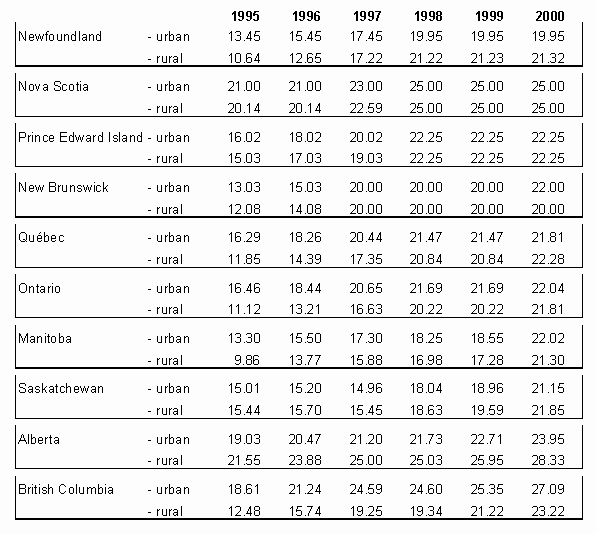
Table 5.3
Residential long distance monthly bill ($)
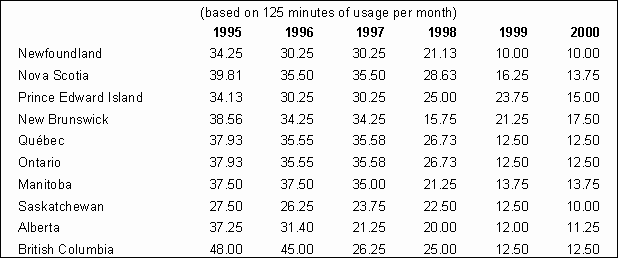
5.3 Business services
Long distance rates have plummeted since 1995. Local rates in urban areas have also declined, while those in rural areas have generally increased since 1995.
The following table shows the impact of the change in business telephone rates, by province between 1995 and 2000.47 [Footnote: Business line pricing uses individual line, non-contracted rates which may differ under multi-line and term contracts which would generally provide a lower rate than that shown. The pricing shown should be considered typical of small business customers. For illustration purposes, a business customer with one line and 250 billed minutes of domestic long distance (Canada-Canada) per month using blended peak/off-peak pricing information was used. Long distance usage per line is approximately equal to the national business average. Actual customer bills would have varied according to location and specific usage patterns. All figures exclude sales taxes.] As illustrated, assuming 250 long distance minutes per month, business customers, both urban and rural, would have realized net savings in their combined basic local and long distance charges.
On average, rural business customers would have realized savings, in 2000, of between $161 and $606 per line. In all provinces, on average, urban customers would have saved more than rural customers.
Table 5.4
Annual business savings (increase) per line
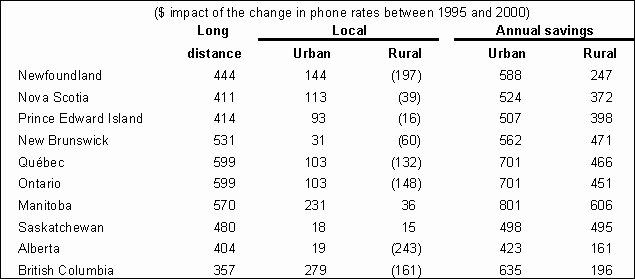
The trends and changes to individual line non-contracted business rates for each province are shown in the following tables.
Table 5.5
Business local rates ($ per month)
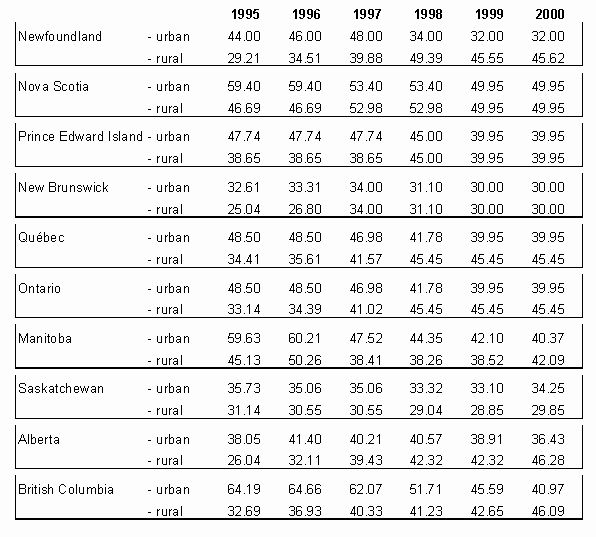
Table 5.6
Business long distance monthly bill per line ($)

5.4 Internet services
Internet pricing for residential customers has decreased significantly since Internet service was first offered.
For the past several years, dial-up Internet has been priced at roughly $10 per month for low-usage and $25 for high usage by both the incumbent telephone companies and major independent ISPs.48 [Footnote: CRTC Industry Survey - 2001. The CRTC surveyed major independent ISPs. Small ISPs may have different pricing plans.]
The cable companies introduced high-speed Internet service in November 1996. The ILECs or their affiliates followed by offering their own high-speed Internet service. Pricing for residential high-speed service has decreased to $40 per month in most parts of the country.49 [Footnote: Prices may be lower with promotions and special offers.]
Internet service for businesses is more complex as business needs vary widely depending upon their size and sector of operation. Based on the information provided in the CRTC Industry Survey - 2001, entry-level business Internet prices range from $65 to $90 per month.
5.5 Mobile services (cellular and PCS)
From a range of $70 to $80 per month in 1995, a mobile subscriber in Canada, on average, now pays from $40 to $60 per month.
Figure 5.1
Mobile monthly revenues per subscriber50
[Footnote: Source: Company reports and internal estimates. TELUS includes Clearnet and TELUS Québec from 1999 onwards.]

6.1 Introduction
Broadband access is a key enabler for a number of new opportunities, including e-commerce, e-learning, e-health and e-government.
Governments in Canada have responded in a number of ways to the challenge of increasing the deployment of broadband infrastructure and services. Initiatives have included contracting for high-speed services for government institutions or personnel, providing seed funding to community projects, providing capital funding for infrastructure projects, providing research and development tax credits to equipment manufacturers, funding trials for broadband applications, and development of web-content.
As well, Industry Canada has made available and licensed the use of new spectrum for fixed wireless services, allocated orbital position for advanced satellite services, and funded a range of broadband initiatives for the purpose of research and application.
The Minister of Industry established the National Broadband Task Force (the Task Force) to map out a strategy to achieve the Government’s goal of making broadband access widely available to citizens, businesses, public institutions and to all communities in Canada by 2004. In addition, the Task Force was asked to advise the Government on issues related to the development and deployment of broadband networks and services in Canada.
6.2 Deployment and Accessibility
Canadian cable and telecommunications companies have made considerable investments in broadband infrastructure over the last several years.
Using Statistics Canada’s "Census Sub-Divisions" to define "communities"51 [Footnote: "Community" for this purpose was defined as "Census Subdivision" (CSD). Some CSDs are geographically large and the map depiction may overstate actual service availability.], and input from service providers, the Task Force found that DSL and/or High-Speed Internet Cable Service (Internet cable) is offered in 1,203 communities, representing approximately 75% of the Canadian population. While services are not available to all residences and businesses in those communities due to limitations in service coverage, it is expected that service providers will extend the coverage of their service in these communities.
The Task Force also found that, in 4,781 communities (combined population of 6.4 million Canadians), neither DSL nor Internet Cable service was available.52 [Footnote: Satellite-based high-speed access services can reach most Canadian communities but are generally more expensive. Fixed wireless services are also currently offered in a limited number of communities. Their commercial application has focused primarily on the provision of business services. The data and maps in this report do not include satellite and fixed wireless services.] These areas present the greatest challenge in development of advanced infrastructure.
A recent study shows that Canada is, by a wide margin, ahead of all other G8 countries in terms of subscription to broadband services per 100 inhabitants, and ranks fourth overall (behind the Republic of Korea, Singapore and Hong Kong).53 [Footnote: Study by International Telecommunications Union (ITU) and Organization for Economic Cooperation and Development (OECD) reported in ITU News, June 2001.] This ranking is particularly striking, given Canada’s vast geographic area and relatively low population density.
Figure 6.1
High-speed access by Canadian communities54
[Footnote: "The New National Dream: Networking the Nation for Broadband Access", Report of the National Broadband Task Force, Industry Canada, 2001, Figure 16.]

The following provides an overview of how high-speed access varies by province / territory.
Figure 6.2
Access to high-speed service by province / territory 55
[Footnote: Ibid., Figure 19.]
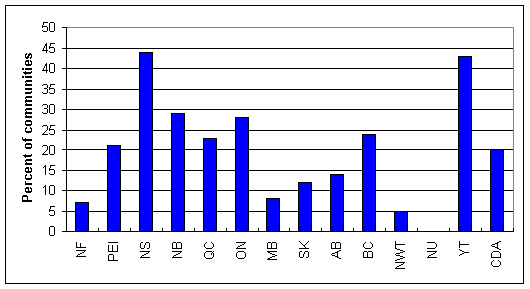
The following maps present information derived from the Task Force survey data to illustrate the current geographic presence of high-speed cable and DSL access by community. Due to the limitations of the study, the maps somewhat overstate the availability of high-speed Internet access in each community. The CRTC will continue to monitor both the deployment of broadband services in unserved communities and their extension in communities presently served.
High-speed Internet access in the North West Territories, Yukon and Nunavut
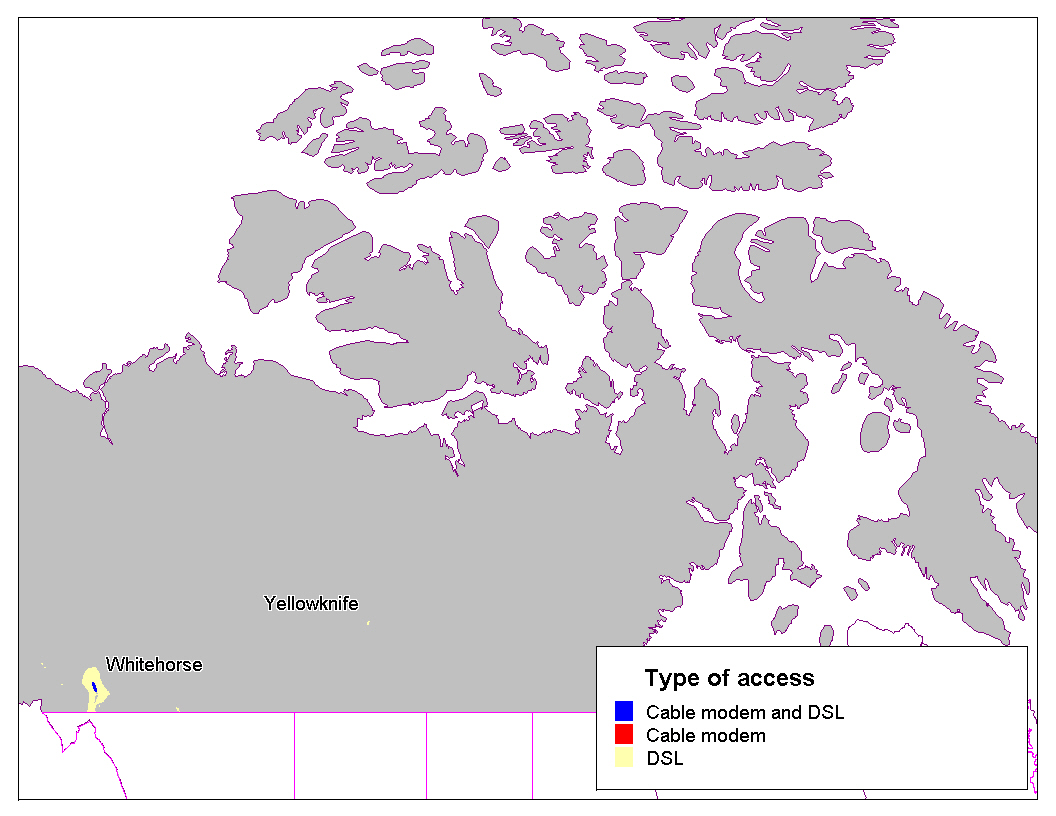
High-speed Internet access in British Columbia

High-speed Internet access in Alberta

High-speed Internet access in Saskatchewan

High-speed Internet access in Manitoba
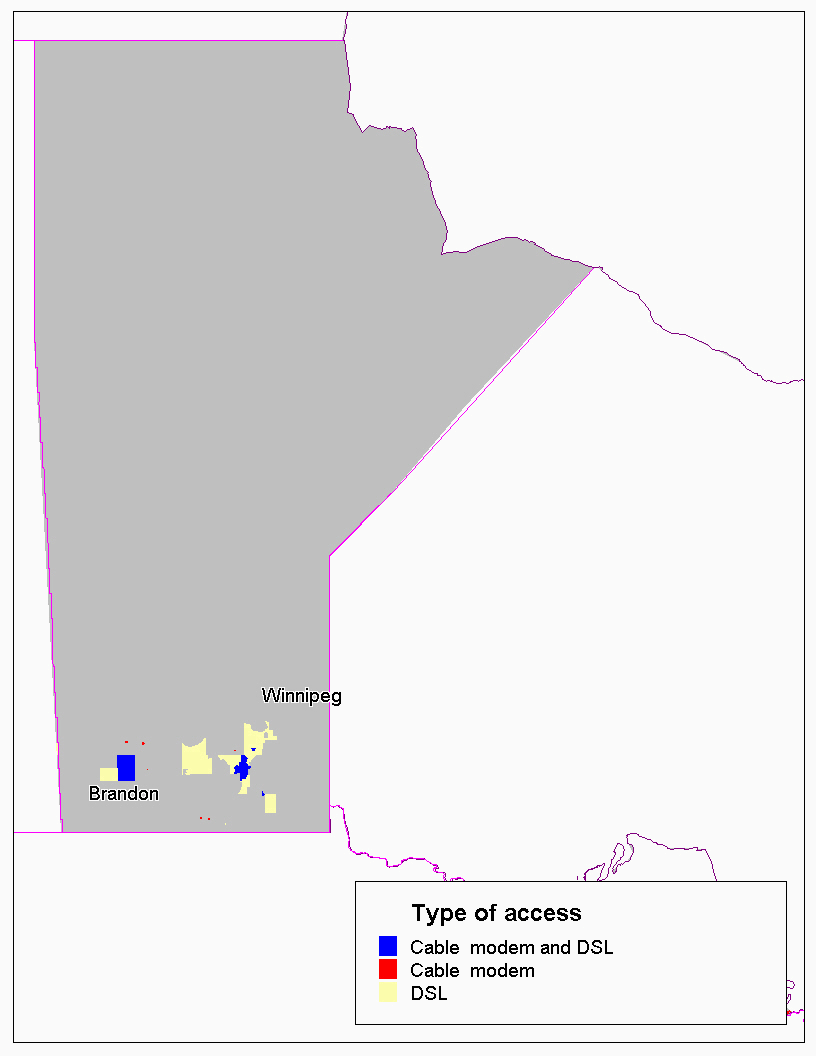
High-speed Internet access in Ontario

High-speed Internet access in Quebec

High-speed Internet access in Atlantic Canada

6.3 Investment in rural areas
Two critical components of broadband infrastructure deployment are transport and access. As defined by the Task Force, transport is the delivery of communications to a point of presence in a community while access is the distribution of communications within a community from that point of presence.
The 4,781 unserved communities face both transport and access issues while the 1,203 underserved communities face mainly access issues. The Task Force has made recommendations for Government, private sector and community initiatives to address these issues.
A number of communities have built local networks with the support of governments and public sector institutions, notably schools, libraries and hospitals. For the many communities within reasonable proximity of major urban areas and fibre routes, the community network can be interconnected to transport facilities using fibre, cable or fixed wireless technologies. However, given the geography of Canada, many communities are distant from major urban areas and fibre routes.
While a small community network can be built to serve local needs, the cost of doing so can be far overshadowed by the cost of interconnecting a remote community to a backbone transport facility. Indeed, many remote areas may be beyond the economic reach of terrestrial facilities and will likely require connections by satellite.
Despite significant progress to date in the deployment of broadband infrastructure and services, considerable efforts and expenditures will need to be made. The Task Force reported the following capital cost estimates to achieve the Government’s broadband deployment goal:
- Transport to unserved communities: $1.3 billion to $1.9 billion;
- Connecting public institutions: $0.5 billion to $0.6 billion;
- Connecting businesses and residences: $0.9 billion to $2.0 billion; and
- Funding community champions: $0.05 billion to $0.07 billion.56 [Footnote: Ibid., page11.]
Technological innovation in telecommunications (increases in speed and capacity) have been substantial and costs have been reduced dramatically, with the most significant breakthroughs having taken place in transport and wireless networks. However, it is unlikely that further developments will cause a significant decrease in the cost of broadband deployment in the near term. Moreover, current conditions in financial markets, and the relatively long payback periods associated with new telecommunications infrastructures, will also impact on the rate of deployment of new facilities.
Absent programs or incentives to encourage investment in advanced telecommunications infrastructure, access to high-speed service may not be provided to all unserved communities by 2004.
In carrying out its statutory mandate, the Commission is called upon to delicately balance often conflicting objectives, including affordability, access to high quality service, increased reliance on market forces, as well as enhancing competition.
The ability of the general body of subscribers to fund targeted initiatives, such as the deployment of broadband infrastructure in isolated communities, is constrained by the need to 1) maintain affordable rates for basic telephone service, and 2) avoid artificial distortions in the competitive marketplace. Moreover, in order to permit competition to evolve, continued reliance on explicit and implicit subsidies will need to be further reduced.
6.4 Promising means of accelerating private sector investment
Many initiatives are already underway in rural communities in Canada to provide improved access to high-speed infrastructure and the capabilities of the Internet. Typically, these projects take the form of the construction of fibre networks, but also include other technologies, such as fixed wireless. The following is a list of some of the initiatives.57 [Footnote: Morrisburg and South Dundas information: Presentation at the CANARIE 5th Advanced Network Workshop; Lanark County information: LCN Press Release, February 16, 1999; Alberta SuperNet information: Presentation May 30, 2001 and Bell Intrigna press release, July 24, 2001; Saskatchewan information: Government of Saskatchewan press release, May 23, 2001; Smart Communities information: Industry Canada, "Smart Communities: Report of the National Selection Committee", 2000.]
Table 6.1
Illustrative list of rural network initiatives
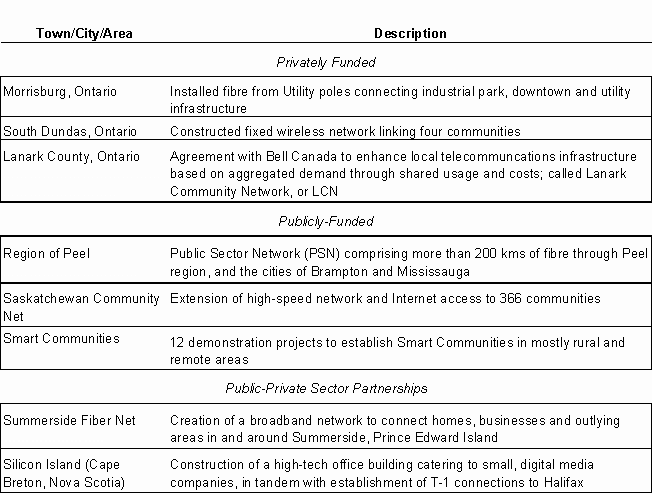
Regarding the Smart Communities project, a national selection committee was struck to evaluate proposals from all ten provinces, one in the North and one in an Aboriginal community that could act as demonstration projects to become a smart community. Twelve projects were chosen in mid-2000 and funding of up to $5 million is to be provided over a three-year period.58 [Footnote: Smart Communities: Report of the National Selection Committee, Industry Canada.]
The methods by which some of these smaller communities have approached the funding and construction of their networks include:
-
using a budgetary surplus generated from their municipal hydro company to provide the necessary funds to construct a small network (Morrisburg);
-
creating a consortium of users to ‘aggregate’ demand for improved communications and networking services and forming a non-profit corporation to carry out feasibility studies and negotiate with carriers (Lanark County); and
-
using less expensive, off-the-shelf technology to build a relatively (as compared to fibre capacity) low capacity radio network linking four smaller communities to higher capacity networks (South Dundas).
Examples of aggregation to facilitate the construction of fibre networks for individual users or communities of users include:
-
Quebec School Boards, through a combined effort of aggregating their communications needs and partnering with other principal or ‘anchor’ tenants, helped fund the construction of local fibre networks which link the schools, administrative centres and other principal locations; and
-
Simcoe Community Access Network, a joint venture of Hydro One Telecom Inc. and a number of local electrical utilities. Hydro One was able to leverage its needs for facilities in this area to assist the local communities in building new advanced infrastructure in their region. This includes both fibre and licence-exempt wireless access technology. The network is expected to be completed in 2002.
In addition to the privately funded and partnership initiatives noted above, there are various government sources of funding that could be leveraged for the deployment of broadband infrastructure.
Some of these programs are outlined in the Table below, which provides an illustrative list of funding programs provided by the Federal and Provincial levels of government to construct high-speed networks and improve access to Internet services.
Table 6.2
Illustrative list of funding alternatives for fibre projects

A number of models exist for private and public sector initiatives to accelerate the deployment of broadband infrastructure. These include:
– A public sector organization, depending on its size, could consume sufficient telecommunications voice and data services to act as an anchor tenant on a new infrastructure build. An anchor tenant providing certainty of demand would facilitate funding of the infrastructure build.
Joint-built networks – A number of private and/or public organizations jointly plan and build a network that meets not only their needs but also those of others. Construction costs are shared, reducing the cost to all and making the project feasible.
Public Network with private sector operators - The government of Alberta has contracted with Bell Intrigna and Axia IP Services Ltd. to act as overall project managers. The private sector operators have made a commitment to build a transport network to 27 core communities. The government of Alberta will invest $193 million to allow the private sector partners to build to an additional 395 communities.59 [Footnote: Alberta SuperNet Presentation, May 30, 2001.] The government of Alberta has agreed to a multi-year contract to obtain high-speed access services from the private sector operators to connect schools and other public institutions.
ILEC investment commitment – Under its next-generation services infrastructure program, MTS has made a commitment to invest $300 million over a three-year period to bring high-speed Internet services to over 85% of Manitobans.60 [Footnote: MTS Press Release, September 22, 2000.]
Public seed funding for community-owned network - Upper Canada Networks (UCNet) in Kemptville, Ontario, is a not-for-profit corporation supported by $1.8 million in provincial (Ontario Ministry of Energy, Science and Technology) and federal funding, with matching contributions from stakeholders such as equipment vendors, school boards and local businesses. Since April 2000, UCNet has deployed wireless broadband services in the Leeds-Grenville area, installing telecommunications towers, 45 Mbps radio trunks and a grid of fibre-optics lines that will ultimately link 212 communities within an area bounded by Cornwall, Gananoque and North Grenville.
As illustrated above, there have been, and continue to be, many initiatives to aggregate local demand and to stimulate supply of advanced telecommunications infrastructure and services in rural areas. The Commission will continue to monitor and report on promising means for accelerating public and private sector investment in rural broadband infrastructure.
Appendix 1
Glossary of terms and acronyms
Analog Service: Transmission of a set of audible
frequencies enabling telephony voice conversations or dial-up Internet access
via a regular telephone line. Virtually all residential telephones are analog
devices. Analog signals are typically converted to a digital format.
Broadband Services: For the purposes of this report, a
service enabling the two-way transmission of voice, data or multimedia
communications with speed in one direction in excess of 1.544 Mbps.
Cable Internet Service: A bi-directional high-speed
digital communication service, enabling Internet access through the use of cable
TV coaxial network.
Central Office: Facility containing telephone equipment
where customers’ calls are switched and transmitted.
Centrex Resale: The purchase and resale of bulk Centrex
service to retail customers.
Centrex Service: A telephone company supplied local
service with associated sets of features (e.g., call display, call forwarding).
Co-Location: An arrangement whereby competitors of an
ILEC can locate facilities at or near the ILEC’s Central Office.
Competitive Local Exchange Carrier (CLEC): A
facilities-based provider of local exchange service, other than an ILEC.
CRTC Interconnection Steering Committee (CISC): A forum
for parties, with CRTC assistance, to resolve local competition implementation
issues of a technological, operational or administrative nature and to resolve
other telecommunications issues.
Data Service: Non-voice services.
Digital Service: The transmission of binary data signals
(a continuous string of zeros and ones). Such service is used for
computer-to-computer communications or for transmission of digitally-encoded
analog signals in telephone and digital cellular networks.
Digital Subscriber Loop (DSL): A local loop equipped to
allow high-speed data transmission.
Exchange: A basic geographical area for the
administration and provision of telephone service by an ILEC, which normally
encompasses a city, town or village and adjacent areas.
Facilities-based Carrier: A carrier that provides
telecommunications services, using, in part, their own switching and
transmission facilities.
Fibre Optics: A broadband transmission facility which
uses a beam of light to transmit a digital signal through a glass strand.
Forward Sortation Area (FSA): First three digits of the
six digit postal code.
Incumbent Local Exchange Carrier (ILEC): A company that,
prior to the introduction of competition, provided monopoly local telephone
service.
Internet: Commonly known as "World Wide Web", a
world wide computer network.
Internet Service: For the purposes of this report,
Internet service includes retail Internet access.
Internet Service Providers (ISPs): Companies that provide
customers with access to Internet services.
Interexchange Private Line (IXPL): A dedicated
communications channel provided at flat rates between points in different
exchanges.
Local Loop: Typically called the "last
mile", the physical connection between the customer premise and the Central
Office.
Local Number Portability (LNP): The ability for customers
to retain their telephone numbers when they change local service provider.
Long Distance Resale: The purchase and resale of bulk
private line and other interexchange services for the provision of long distance
services to retail customers.
Mobile Services: Wireless services including analog and
digital cellular (e.g. Personal Communications Services or PCS).
Narrowband Services: For the purposes of this report, a
service enabling the two-way transmission of voice or data communications with
speed in either direction not exceeding 64 Kbps.
Private Line Service: A dedicated communications channel
provided at flat rates between points in the same exchange.
Stentor: The former national alliance of incumbent
carriers.
Support Structure: Structures, such as poles and conduit,
that support transmission facilities (copper cable and/or fibre optics).
Terminal Equipment: Equipment located at the customer’s
premises, used for voice or data communications (e.g. telephone set).
Virtual Data Network: The use of a shared network to
provide partitioned capabilities for a group of users, providing users with the
appearance of a private network.
Wideband: For the purposes of this report, a service
enabling the two-way transmission of voice or data communications with speed in
either direction of greater than 64Kbps up to and including 1.544 Mbps.
Wireless Services: Telecommunications services via the
airwaves - radio, cellular, satellite, microwave, etc., and includes fixed
wireless.
Wireline Service: Telecommunications services offered
over wires.
Appendix 2
Presence of local service providers by major urban centre
Vancouver/Victoria
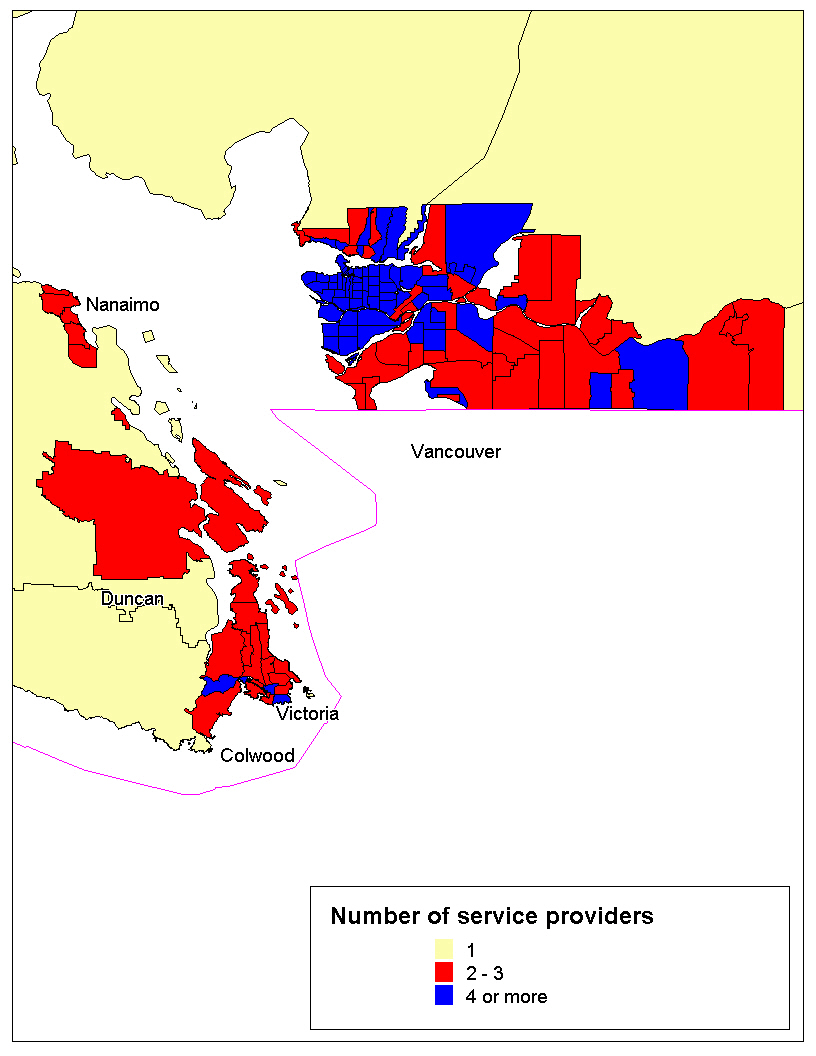
Presence of local service providers shown in the maps is
somewhat overstated due to limitations of the survey. As well, not all
customers, particularly residential, can choose to switch to a local competitor.
Calgary

Edmonton

Regina

Winnipeg

Southwestern Ontario

Toronto/Southern Ontario

Ottawa/Hull

Montréal

Québec City

Halifax

St. John's

Appendix 3
Presence of high-speed Internet access service providers by major urban centre
Vancouver/Victoria
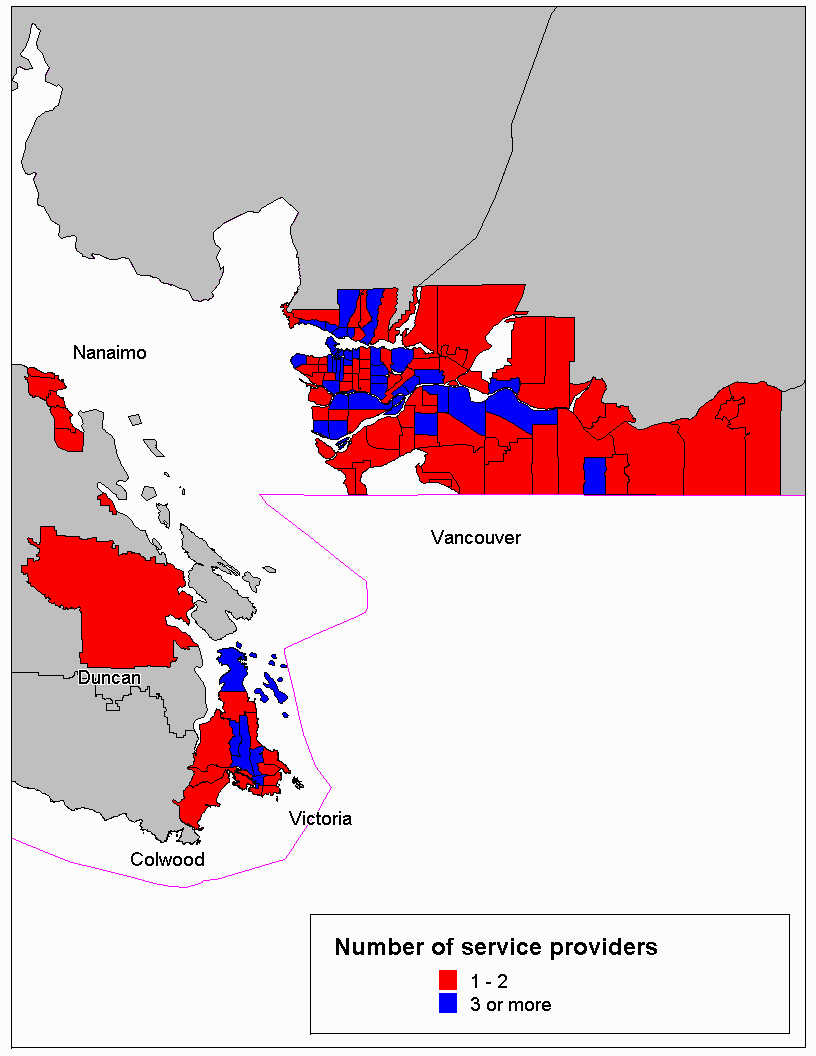
Presence of high-speed Internet access service providers shown
in the maps is somewhat overstated due to limitations of the survey.
Calgary

Edmonton

Regina
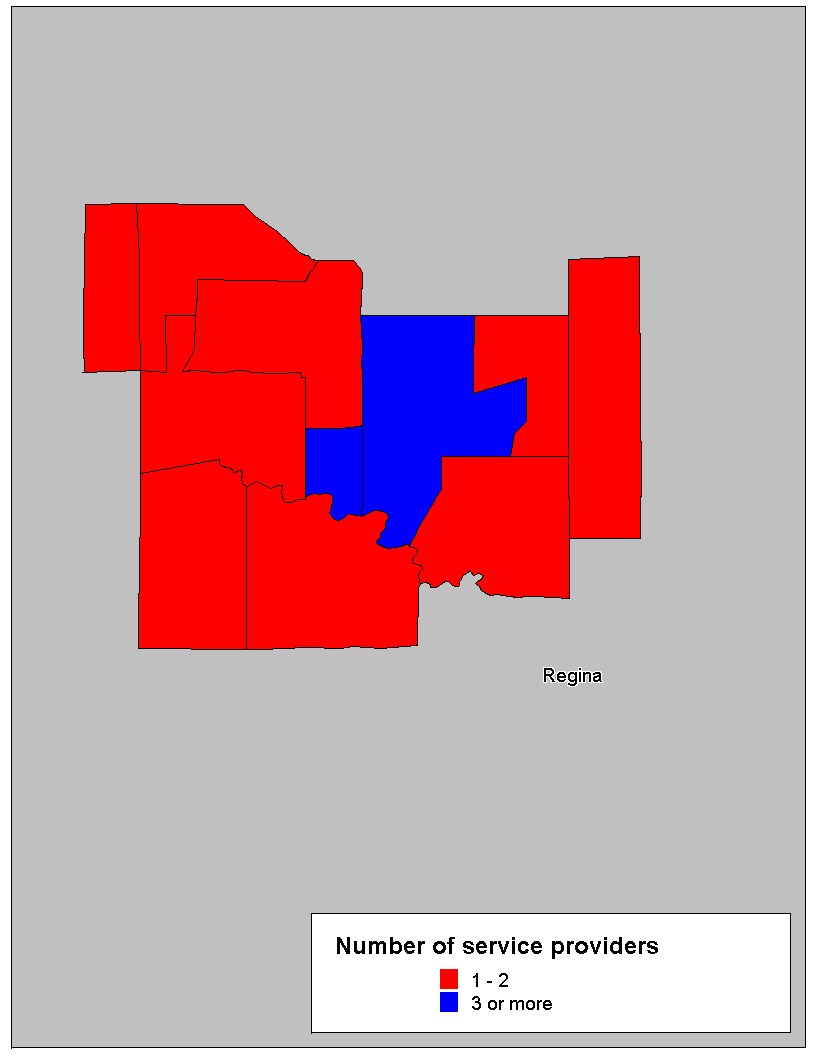
Saskatoon

Winnipeg
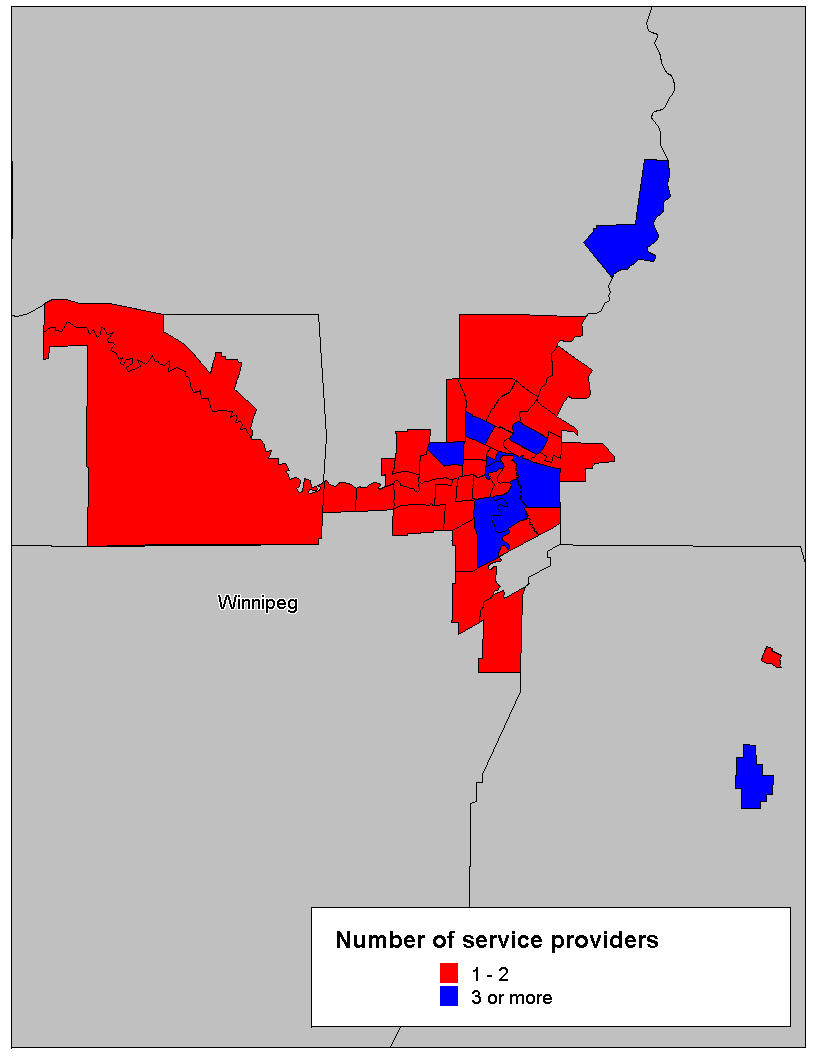
Southwestern Ontario

Toronto/Southern Ontario
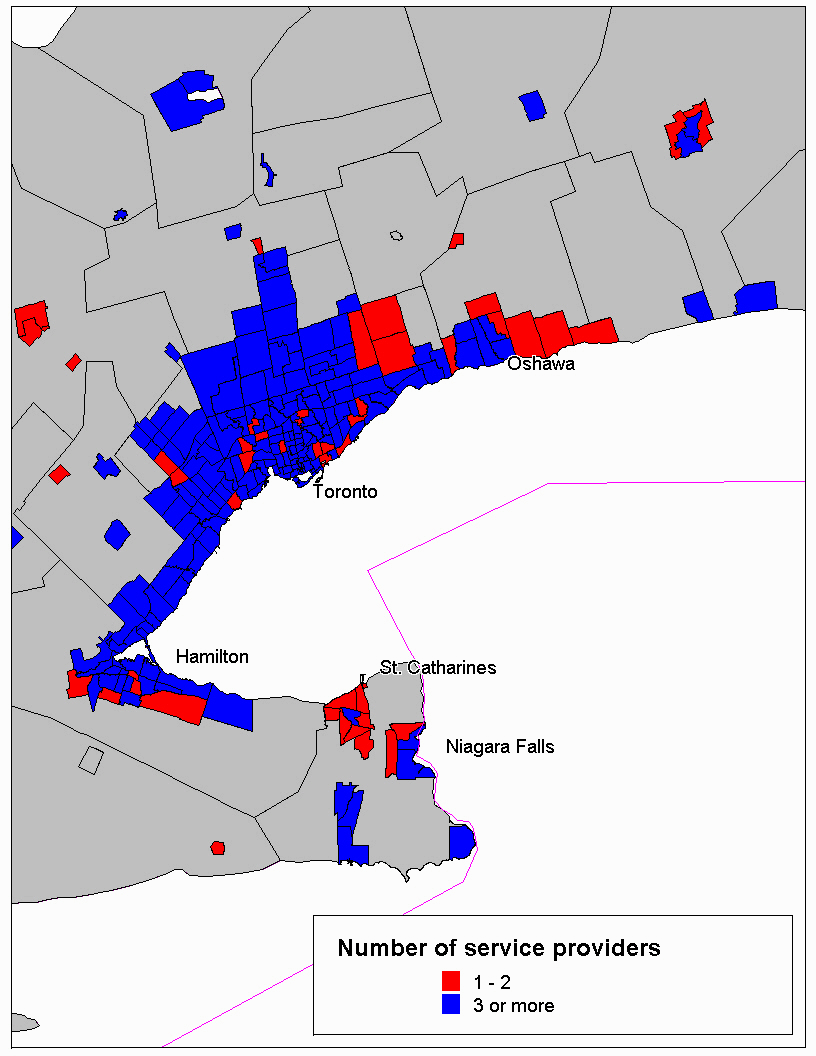
Ottawa/Hull

Montréal

Québec City

Saint John

Halifax
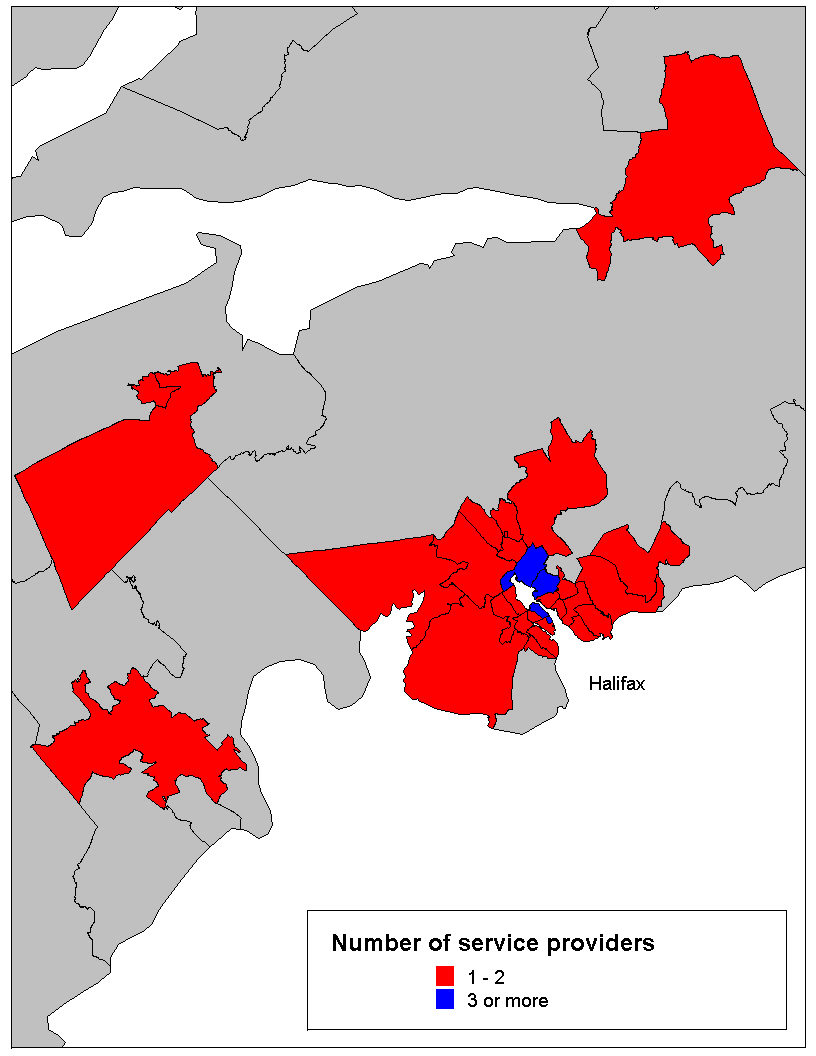
St. John's

Date Modified: 2001-09-28
|